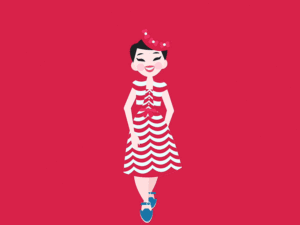Personal color analysis is an important tool for you to find clothes that enhance your skin and suit you. Know more!
Have you ever seen a beautiful dress on someone, whether on the street, at an event, or on television, but when you tried on a similar model, did you feel pale? Or borrowed that beautiful blouse from your friend, but it didn’t fit on you?
All of this can have an explanation: the colors!
Each color “behaves” differently depending on the skin tone of each person. Colors can enhance or disguise imperfections, change the appearance of the skin and highlight points on the face, for example.
Knowing what your color is is essential to choose pieces that really fit you and don’t highlight points you would like to disguise, such as dark circles, which can leave you looking tired or aged.
To find out what your color chart is, it’s important to perform a personal color analysis. And that’s what we’re going to talk about in this content. Read on, understand the importance of color and how a personal color analysis is performed.
What is personal coloring?
Personal color analysis, also called colorimetry, is a study that seeks to identify the tone and undertone of the skin, through characteristics such as hair and eye color and also skin temperature.
Personal color analysis is a step in the style consultancy that discovers and highlights the “ideal colors” for each biotype. The objective is to define which shades are most suitable and which enhance the natural aspects of each person.
These studies have been carried out since the beginning of the 20th century, but it has been in recent years that the analysis of personal color has gained even more importance and prominence.
Starting with the skin’s temperature characteristic, it can be divided into three main types: warm colors, cool colors and neutral colors.
If your wrist veins are more greenish, your skin tone is likely to be warm. If the tone is more bluish, it tends to be cold. The neutral tone is in the middle. The skin in warm tones has a more yellowish and greenish tone and the skin in cold tones has a more rosy and reddish appearance.
Based on this analysis, each person’s color palette is defined, which can be one of four seasons: spring, summer, autumn and winter.
Around the 1990s, Mary Spillane, image and style consultant improved this method, and divided the 4 stations into 12 different classifications, which are currently used:
- spring light
- hot spring
- intense spring
- mild summer
- light summer
- pure summer
- hot autumn
- intense autumn
- deep autumn
- mild winter
- pure winter
- deep winter
Each of these divisions is a different color chart, which has its main colors and those that are not recommended.
How to discover your color chart
A style and image consultant is the most suitable professional to carry out this analysis and discover your personal color. At the time of analysis, this professional has a mirror, natural light and several samples of fabrics, in different colors.
The fabrics are placed close to the person’s face, and the professional analyzes the reflection that each color has on dark circles, skin tone and face contour through methodologies.
The objective is to match the colors of our hair, eyes, veins and also the skin temperature with the color of our clothes. Thus, the look is harmonic, important points are highlighted, and dark circles, expression lines and even that tired look can be disguised.
A complete analysis includes, in addition to identifying the skin temperature, the level of personal contrast of each person through the skin, eyes and hair combination. If the tones are very similar, the contrast is low, if the tones are very divergent (white skin and black hair, black skin and blonde hair) the contrast is high, if they are different but not contrasting, they are considered medium.
The most intriguing thing is that experts say that we should repeat the same kind of personal contrast in the clothes we wear, so everything is more harmonious. In other words, the colors really have the super power to make all the difference in a production!
How to match colors?
One of the tools that styling professionals use to combine colors is the color wheel. It shows complementary and analogous colors in a quick and practical way, coordinating the professional in defining the tones indicated for their skin temperature and type of contrast.
All of this helps to identify and determine the colors that brighten your face, disguise tiredness, harmonize with your appearance and go far beyond a tired and aged look.
Performing a personal color analysis is a great way to learn more about your own style. Thus, it brings a direction of the colors more or less indicated when buying the pieces.
It also allows for more conscious consumption, so that situations like the ones we commented on at the beginning of the content do not happen, when you buy a piece that looks beautiful on your friend, for example, but does not suit you.
If you liked the tips, leave a comment! I’d love to hear from you!




[…] Discover the best colors for your look here! […]
[…] See how to find your personal color here! […]